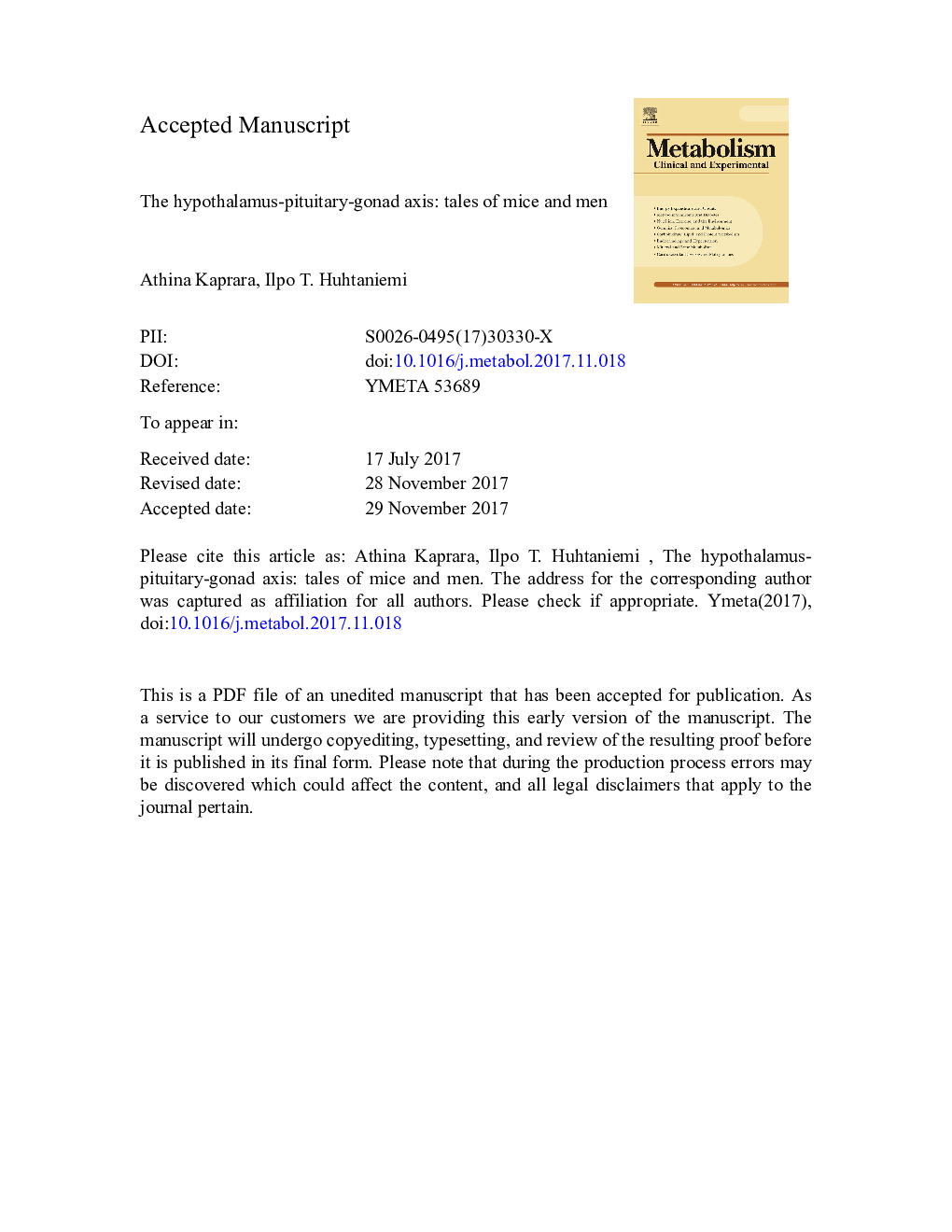| کد مقاله | کد نشریه | سال انتشار | مقاله انگلیسی | نسخه تمام متن |
|---|---|---|---|---|
| 8632832 | 1569023 | 2018 | 32 صفحه PDF | دانلود رایگان |
عنوان انگلیسی مقاله ISI
The hypothalamus-pituitary-gonad axis: Tales of mice and men
ترجمه فارسی عنوان
محور هیپوتالاموس-هیپوفیز گناد: داستانهای موشها و مردان
دانلود مقاله + سفارش ترجمه
دانلود مقاله ISI انگلیسی
رایگان برای ایرانیان
کلمات کلیدی
GnRH receptorsIGF-1IP3PSA-NCAMGPCRPKCDHEASHPGEGR-1NELFFGFR1HGFDLX2LRRFGF8GPR54KISS1RPROK2GnRH pulse generatorrxraGnRHTGF-βinositol-trisphosphatepKaCREBEGFRJnkNPYDSDGnIHERKc-Jun N-terminal kinase - C-Jun N-terminal kinasecAMP - cAMPMAPK - MAPKadenylyl cyclase - آدنیلات سیکلاز، آدنیلیل سیکلازamino acid - آمینو اسیدDisorder of sexual development - اختلال رشد جنسیgamma-aminobutyric acid - اسید گاما آمینو بوتیریکHCG - اچ سی جیtransforming growth factor-β - تبدیل فاکتور رشد βLeucine-rich repeats - تکرار غنی از لوسینCNS - دستگاه عصبی مرکزیDREAM - رویاKallmann syndrome - سندرم کالمنdehydroepiandrosterone sulfate - سولفات dehydroepiandrosteronecentral nervous system - سیستم عصبی مرکزیFibroblast growth factor 8 - عامل رشد فیبروبلاست 8Hepatocyte growth factor - عامل رشد هپاتوسیتinsulin-like growth factor 1 - فاکتور رشد مانند انسولین 1Rara - نادرGonadotropin-releasing hormone - هورمون آزاد کننده گنادوتروپینfollicle-stimulating hormone - هورمون تحریک کننده فولیکولluteinizing hormone - هورمون جسم زردFSH - هورمون محرکه فولیکولی Gonadotropin-inhibitory hormone - هورمون مهارکننده گنادوتروپینHypothalamic-pituitary-gonadal - هیپوتالاموس-هیپوفیز-گونادالHypogonadotropic hypogonadism - هیپوگنادیسم هیپوگونادوتروپیکearly growth response-1 - پاسخ سریع رشد 1cAMP response element-binding protein - پروتئین واکنش القا کننده واکنش cAMPprotein kinase A - پروتئین کیناز AProtein kinase C - پروتئین کیناز سیmitogen-activated protein kinase - پروتئین کیناز فعال با mitogenProkineticin 2 - پروکینتیکین 2Extracellular signal–regulated kinase - کیناز تنظیم شده با سیگنال غیر سلولیGABA - گاباhuman chorionic gonadotropin - گونادوتروپین کوریونی انسانEstrogen receptor - گیرنده استروژنEpidermal growth factor receptor - گیرنده فاکتور رشد اپیدرمالFibroblast growth factor receptor 1 - گیرنده فاکتور رشد فیبروبلاست 1G protein-coupled receptor - گیرندههای جفتشونده با پروتئین جیNeuropeptide Y - یوروپروتئین Y
موضوعات مرتبط
علوم زیستی و بیوفناوری
بیوشیمی، ژنتیک و زیست شناسی مولکولی
علوم غدد
چکیده انگلیسی
Reproduction is controlled by the hypothalamic-pituitary-gonadal (HPG) axis. Gonadotropin-releasing hormone (GnRH) neurons play a central role in this axis through production of GnRH, which binds to a membrane receptor on pituitary gonadotrophs and stimulates the biosynthesis and secretion of follicle-stimulating hormone (FSH) and luteinizing hormone (LH). Multiple factors affect GnRH neuron migration, GnRH gene expression, GnRH pulse generator, GnRH secretion, GnRH receptor expression, and gonadotropin synthesis and release. Among them anosmin is involved in the guidance of the GnRH neuron migration, and a loss-of-function mutation in its gene leads to a failure of their migration from the olfactory placode to the hypothalamus, with consequent anosmic hypogonadotropic hypogonadism (Kallmann syndrome). There are also cases of hypogonadotropic hypogonadim with normal sense of smell, due to mutations of other genes. Another protein, kisspeptin plays a crucial role in the regulation of GnRH pulse generator and the pubertal development. GnRH is the main hypothalamic regulator of the release of gonadotropins. Finally, FSH and LH are the essential hormonal regulators of testicular functions, acting through their receptors in Sertoli and Leydig cells, respectively. The main features of the male HPG axis will be described in this review.
ناشر
Database: Elsevier - ScienceDirect (ساینس دایرکت)
Journal: Metabolism - Volume 86, September 2018, Pages 3-17
Journal: Metabolism - Volume 86, September 2018, Pages 3-17
نویسندگان
Athina Kaprara, Ilpo T. Huhtaniemi,
